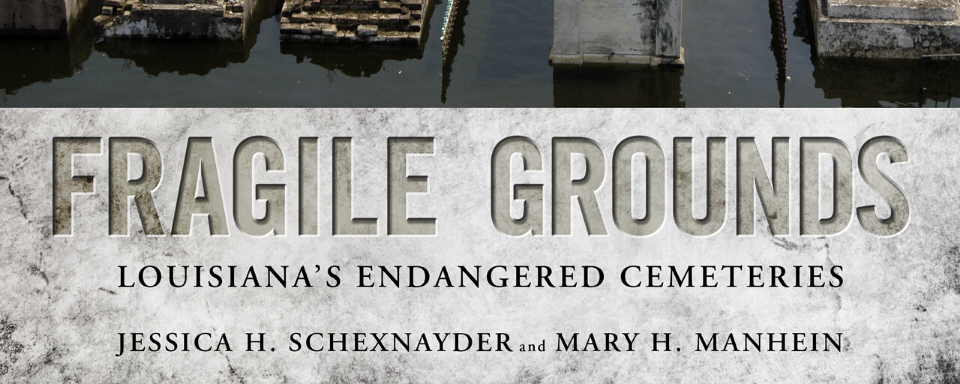
Documenting the Dying Histories of Coastal Communities
by Jessica H. Schexnayder
Each year, the Association of University Presses hosts a blog tour in celebration of University Press Week. This year’s theme explores how university presses can help teach us “How to…” Today’s topic is focused on environmental stewardship. We asked Jessica H. Schexnayder, author of Fragile Grounds: Louisiana's Endangered Cemeteries, what being an environmental steward meant to her. Fragile Grounds, co-written with Mary H. Manhein, is a visual treasury of disappearing cemeteries and a call to preserve and document them.
When thinking of environmental stewardship – the caring for and of the land – the idea of sustainability comes to mind. But what does sustainability entail when the landscape is dynamic, such as the Louisiana delta? Living in a delta is a precarious dance with nature due to its fluid, ever-evolving course. In this scenario, environmental stewardship must focus on the sustainability of the land, the resources – both natural and cultural – and the resiliency of the people inhabiting the landscape.
Louisiana’s coastal shape is unlike any other in the nation. Whereas other coastal states have easily-defined borders, Louisiana’s seaward landmass is comprised of delicate fingers of marshland extending into the Gulf of Mexico – a fragile environ vulnerable to storm surge, erosion, subsidence, sea level rise and climate change. As people flee inland due to these forces, evidence of their histories, including physical culture, are often left behind.
Public thought pattern toward our nation’s coasts often turns to east and west. The Gulf, or third coast, is generally an afterthought until a natural or manmade disaster strikes, bringing it to the forefront. Five states encompass the Gulf in an arc, with Louisiana near the center. It is at this junction where the state’s frail marshes meet the stressors of the Gulf of Mexico. Louisiana’s erosional land loss is staggering, with nearly an acre of land lost every hour. The situation is so dire that Louisiana has the first community in the lower 48 states, Isle de Jean Charles, that has been forced to retreat due to rapid land loss, essentially making the inhabitants the nation’s first climate refugees.
One aspect not often reflected in public commentary is what happens to a community’s cultural assets, such as its cemeteries, when the landscape is no longer habitable. Cemeteries associated with the culturally-rich communities of coastal Louisiana reflect the history and global settlement patterns of the state. Yet, many are endangered due to the fragile landscape. Although these endangered sites provide valuable clues to past and present community identities, migration leaves them abandoned, neglected and often overlooked as part of the cultural landscape. The aforementioned Isle de Jean Charles is one such scenario. The notion of moving a cemetery to a new locale is desirable, but hardly realistic. Candidly, when the land goes, the cemetery goes with it.
In 2011, I partnered with fellow researcher, Mary Manhein, to document Louisiana’s endangered cemeteries. Funded by Louisiana Sea Grant, our project spanned five years in which we recorded the dying histories of the state’s coastal communities as reflected through their cemeteries. Our goal was to create a digital record through GPS mapping, photography, oral histories and cultural artifact documentation. To date, records include polygon maps of 138 cemeteries and more than eleven-thousand photographs in 24 parishes, and have been utilized by both the Louisiana Department of Health and the Federal Emergency Management Agency in recent post-storm recovery.
In many communities we visited, people wanted to share their stories – the cultural fabric and underlying unity of these sites. This connection of people to place led to the writing of Fragile Grounds: Louisiana’s Endangered Cemeteries (Schexnayder and Manhein), an award-winning book published in 2017 by University Press of Mississippi as part of the America’s Third Coast series. We were honored to be included in the series which, “offers important insights on Gulf Coast history, life, and culture that focus on areas and issues either neglected entirely or mentioned only in passing elsewhere.”
Fragile Grounds is a compilation of vignettes and photographs of Louisiana’s fragile burial places and coastal community structures, tying together the social aspects and hard science realities of what Louisiana stands to lose. Once lost, that past cannot be recovered.

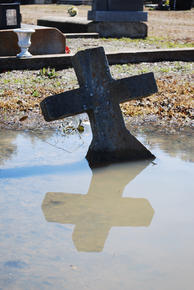
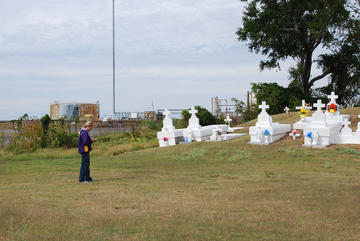
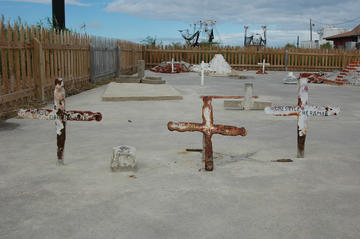
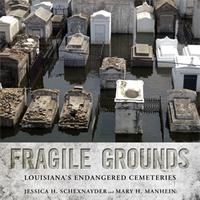
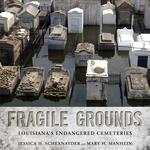


Comments